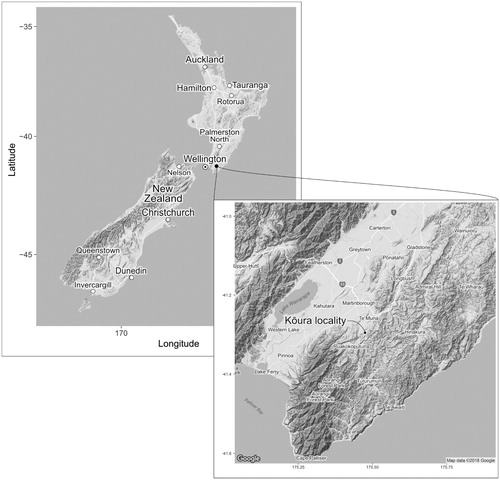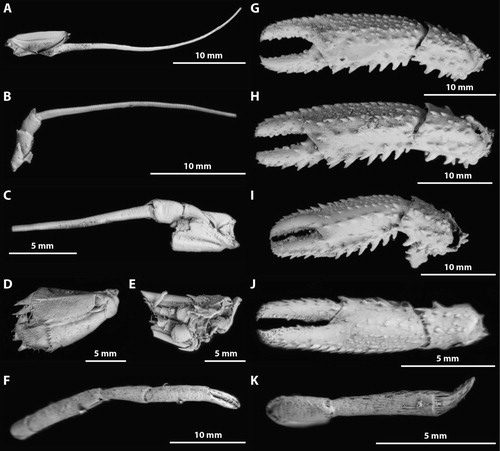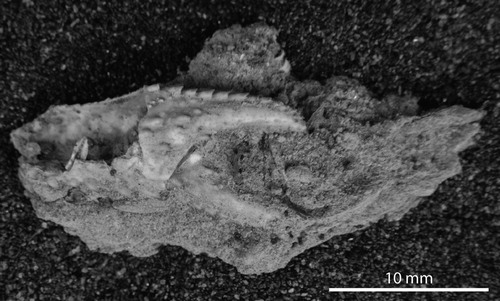ABSTRACT
Here we report an early Pleistocene occurrence of the New Zealand freshwater crayfish (kōura) Paranephrops White 1842 in the marginal-marine sediments of the Hautotara Formation, southeastern Wairarapa. The disarticulated parts are tentatively assigned to P. ?planifrons. This, to our knowledge, is the first fossil occurrence attributable to an extant species of Paranephrops, and only the second fossil occurrence of Paranephrops reported in the literature. This find provides a maximum constraint on the age of divergence of the two extant species of Paranephrops, and shows that post-glacial recovery of freshwater ecosystems in the North Island may have been rapid if the Northland refugium hypothesis for survival and dispersal of Paranephrops planifrons is accurate.
Assorted disarticulated kōura (Paranephrops ?planifrons White Citation1842) parts were recovered in 2016 from an ephemeral (and no longer accessible) outcrop of the Nukumaruan Hautotara Formation (Pleistocene: 2.4–1.63 Ma) (Nowland Citation2011) in the Makara River, southeastern Wairarapa, New Zealand (). The outcrop consisted of a c. 1 m thick blue-grey mudstone unit with a basal 10 cm discontinuous shell lens of Austrovenus stutchburyi (Wood Citation1828), c. 50 m from the Hautotara Bridge and c. 6 m stratigraphically above the base of the Hautotara Formation (Victoria University of Wellington (VUW) locality number V 101018; FRF number S27/f0706). The fossil material mostly consists of chelipeds, but walking legs, antennae, part of the cephalothorax with eyes and antenna bases, and one uropod were also recovered ().
Figure 1. Map of kōura locality in the Wairarapa, New Zealand. Base maps downloaded from Google Maps and plotted using R package ggmap (Kahle and Wickham Citation2013).

Figure 2. Nukumaruan (Pleistocene) Paranephrops ?planifrons from the Hautotara Formation, Wairarapa. VA411 A-C: Antennae. D: Uropod. E: Partial cephalothorax. F, K: Walking legs. G-J: Chelipeds. Specimens whitened with MgO and photographed at VUW by M. F. G.

Figure 3. Nukumaruan (Pleistocene) Paranephrops ?planifrons from the Hautotara Formation, Wairarapa. VA411 L: Cheliped partially prepared out of matrix and photographed at VUW by M. F.G.

The Hautotara Formation is a highly variable sedimentary unit consisting of interbedded marginal marine sandstones and mudstones with minor limestone and conglomerate facies. The formation records the closure of the Ruataniwha Strait, a major Plio-Pleistocene paleoseaway that divided the eastern North Island (Beu, Citation1995, Nowland Citation2011, Trewick and Bland Citation2012). Stratigraphically, the Hautotara Formation sits above the fully marine Pukenui Limestone, and is overlain by the terrestrial and lacustrine Te Muna Formation (Begg & Johnston Citation2000, Nowland Citation2011).
We interpret the occurrence of Paranephrops, a freshwater crustacean, in the same unit as the estuarine bivalve Austrovenus stutchburyi, as being indicative of post-mortem or post-moult transportation of kōura parts downriver to the coast. We interpret the bed they were present in as a coastal deposit of sediment that was being flushed out of a river. The fossil kōura parts were largely concentrated on the surface of the outcrop, partially embedded to some degree, but some digging revealed specimens still fully embedded in matrix (). Based on comparison of our specimens to the description and illustrations in Hopkins (Citation1970), we refer them to P. ?planifrons largely on the basis of the sparsely tuberculate nature of the chelipeds. Unfortunately no complete cephalothorax or rostrum was recovered, and so we are unable to more confidently assign this collection of body parts to a species. The specimens are accessioned into the Victoria University of Wellington collection as VUW Arthropod Fossil Ledger number VA 411 A-L (cleaned, mounted and whitened specimens A – K illustrated here as , specimen L partially prepared from matrix and illustrated as ).
The fossil distributions of New Zealand terrestrial and freshwater endemics are of considerable interest to conservation biology, evolutionary biology, and paleogeography. Fossil evidence can provide important calibration points for phylogenetic analyses, allowing absolute divergence times to be calculated (Donoghue and Benton Citation2007; Marshall Citation2008). Terrestrial and freshwater fossils suitable for this are, however, rare. An early–middle Miocene (Otaian–Lillburnian) species of parastacid, Paranephrops fordycei Feldmann and Pole (Citation1994), has been described from the Dunstan Formation in Central Otago, and was used by Apte et al. (Citation2007) to represent the most recent common ancestor of P. planifrons and P. zealandicus, meaning that divergence of these lineages must have occurred sometime later. Apte et al. (Citation2007) thus constrain the earliest possible divergence of the two modern kōura species to a minimum age of 10 Ma. This new find of P. ?planifrons could be similarly used to constrain the maximum age of divergence (i.e. the time by which it must have already occurred) to the early Pleistocene (although see Apte et al. Citation2007 for commentary on the robustness of the morphological characters used to diagnose species of Paranephrops compared to molecular data).
Whereas biogeographical hypotheses can be constrained using evidence of geological barriers to dispersal (e.g. MacDowall Citation2005; Trewick and Bland Citation2012), phylogenetic analyses of living taxa can also provide evidence for paleogeographical reconstructions. Kōura are important species in stream communities, fulfilling multiple ecological functions, including predation, bioturbation, and grazing (Usio and Townsend Citation2000), and like many freshwater taxa are not known to be able to survive persistent snow and ice cover (McDowall Citation2005). Apte et al. (Citation2007) hypothesise that during the Pliocene marine transgression and/or the glacial stages of the Pleistocene, P. planifrons may have been restricted to the Northland region, and subsequently recolonised the North Island in a north–south direction. If this is the case, the occurrence of Paranephrops material in the Hautotara Formation, immediately above the glacial-interglacial cycles recorded in the Pukenui Limestone, shows that terrestrial conditions in the North Island must have recovered to the point that kōura could move this far south relatively rapidly (in geological terms) post-glaciation.
Summary
To our knowledge this is the first fossil Paranephrops potentially attributable to an extant species that has been reported from New Zealand. It provides a maximum age for the divergence of P. planifrons and P. zealandicus, and shows that temperature and conditions in freshwater systems suitable for kōura to move south from a Northland refugium were reached in the southern North Island relatively rapidly in the post-glacial recovery of terrestrial environments in the southern North Island
Detailed conclusions are not possible on the basis of a single occurrence, but we hope that this find will prove a useful contribution to future efforts in the ongoing reconstruction of New Zealand paleobiogeography.
Acknowledgements
We acknowledge the use of the Fossil Record Electronic Database (www.fred.org.nz) and the field assistance of Manuela Franco da Silva, Georgia Grant, Jane Chewings, and Ben Hines. Ben Hines and Amy Brown are thanked for their helpful edits to the manuscript. These specimens were originally collected while on an undergraduate fieldcamp conducted by Victoria University of Wellington, New Zealand, and we acknowledge the logistical support provided by the staff on that trip, particularly trip leaders Cliff Atkins and Mike Hannah. We thank Rodney Feldmann and one anonymous reviewer for their insights and helpful reviews.
Disclosure statement
No potential conflict of interest was reported by the authors.
ORCID
Katie S. Collins http://orcid.org/0000-0002-3379-4201
References
- Apte S, Smith PJ, Wallis GP. 2007. Mitochondrial phylogeography of New Zealand freshwater crayfishes, Paranephrops spp. Mol Biol. 16:1897–1908.
- Begg JG, Johnston MR. 2000. Geology of the Wellington area: scale 1:250,000. Lower Hutt: Institute of Geological & Nuclear Sciences. 1:250,000 Geological Map 10. 64p.
- Beu AG. 1995. Pliocene limestones and their scallops. Lithostratigraphy, pectinid biostratigraphy and palaeogeography of eastern North Island Late Neogene limestone. Institute of Geological and Nuclear Sciences Monograph 10. Lower Hutt, Institute of Geological and Nuclear Sciences.
- Donoghue PC, Benton MJ. 2007. Rocks and clocks: calibrating the tree of life using fossils and molecules. Trends Ecol Evol. 22(8):424–431. doi: 10.1016/j.tree.2007.05.005
- Feldmann RM, Pole M. 1994. A new species of Paranephrops White 1842: a fossil freshwater crayfish (Decapoda: Parastacidae) from the Manuherikia Group (Miocene), Central Otago, New Zealand. N Z J Geol Geophys. 37(2):163–167. doi: 10.1080/00288306.1994.9514611
- Hopkins CL. 1970. Systematics of the New Zealand freshwater crayfish Paranephrops (Crustacea: Decapoda: Parastacidae). N Z J Mar Freshwater Res. 4(3):278–291. doi: 10.1080/00288330.1970.9515347
- Kahle D, Wickham H. 2013. ggmap: spatial visualization with ggplot2. R Journal 5:144–161; [accessed 2016 October 30]. http://journal.r-project.org/archive/2013-1/kahle-wickham.pdf.
- McDowall RM. 2005. Historical biogeography of the New Zealand freshwater crayfishes (Parastacidae, Paranephrops spp.): Restoration of a refugial survivor? N Z J Zool. 32(2):55–77. doi: 10.1080/03014223.2005.9518399
- Marshall CR. 2008. A simple method for bracketing absolute divergence times on molecular phylogenies using multiple fossil calibration points. Am Nat. 171(6):726–742. doi: 10.1086/587523
- Nowland SW. 2011. The early quaternary marine to terrestrial transition of the Southeastern Wairarapa, New Zealand [Unpublished Masters Thesis], New Zealand: Victoria University of Wellington.
- Trewick SA, Bland KJ. 2012. Fire and slice: palaeogeography for biogeography at New Zealand’s North Island/South Island juncture. J R Soc N Z. 42(3):153–183. doi: 10.1080/03036758.2010.549493
- Usio N, Townsend CR. 2000. Distribution of the New Zealand crayfish Paranephrops zealandicus in relation to stream physico-chemistry, predatory fish, and invertebrate prey. N Z J Mar Freshwater Res. 34(3):557–567. doi: 10.1080/00288330.2000.9516957
- White A. 1842. Description of an orthopterous insect and two new species of Crustacea from New Zealand in the collection of the British Museum. Zool Miscellany. 2:78–79.
- Wood W. 1828. A supplement to the Index testaceologicus; or a catalogue of shells, British and foreign. Illustrated with 480 figures. London.
